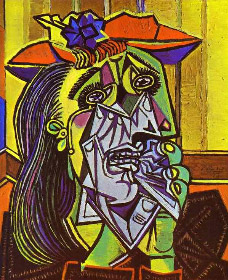
| HOME |
| NERVE |
| REVIEWS |
| ARCHIVE |
| EVENTS |
| LINKS |
| ABOUT US |
| CONTRIBUTORS |
| BACK ISSUES |
| CONTACT US |
 Picasso:
Peace and Freedom
Picasso:
Peace and Freedom
Tate Liverpool
21st May - 30th August 2010
Admission £10 (£8 concessions)
Reviewed by Louise Waller
Picasso: Peace and Freedom opened at Tate Liverpool on Friday 21st May. The exhibition attempts to fit Picasso's art within the time-frame of its creation, relating to political events that he would have been conscious of. Picasso said he did not paint war, but that painting is just another way of keeping a diary.
We begin the exhibition in 1944 with 'The Charnel House'. This piece is visually linked to 'Guernica', Picasso’s most important political artwork. Guernica is on permanent display in Madrid but it is worth a visit to the first floor to see his 'Weeping Woman' of 1937, made in the same year and with the same theme. These works express the anguish and desperation of Picasso’s feelings about the Spanish Civil War. Guernica was a Basque town destroyed in the conflict, the painting focuses on the moment of explosion within the town centre. 'The Charnel House' is painted in similar grisaille (shades of black, white and greys) which visually relate to the newspapers and media that would have relayed events to Picasso, who lived in France. 'Charnel House' is an interior of a family home and the moment of action is long over. Looking at this piece I felt as though I had come across this stale scene of death several hours after the chaos.
Numerous works displayed show the 'Dove of Peace' emblem, and examples of how it was developed and used. Picasso only ever visited England once, and was never granted a visa to visit America, due to his membership of the French Communist Party. For further research I read Gertje Utley’s 'Picasso: The Communist Years'.
Time is a constant theme throughout the exhibition, and can be interpreted with regard to international political events, as well as within a timeframe of Picasso’s personal relationships, also relating to relationships with his contemporaries and the great masters of art history. All the artworks in Peace and Freedom were created by a man aged between sixty and ninety. He was aware of his own mortality and felt a need to ensure his place within art history.
Picasso pitched himself against old masters Delacroix, Velasquez and Manet, by interpreting works in his own style, often with a hint of biography and political satire. Even in his late eighties he created works in an abstract expressionist style, allowing links to be made with the upcoming abstract expressionist movement, and Willem de Kooning in particular.
Sorry Comments Closed
Comment left by Martin Wards on 10th June, 2010 at 15:40
Like this review as it was short and sweet, was to th point about what it was getting across and the reviewer had very good knowledge of art and its history. Good piece of writing.
Comment left by peter mackay on 12th June, 2010 at 9:18
This review sums up the exhibition very well.We thoroughly enjoyed the exhibition & the way it was displayed
Comment left by juro on 14th June, 2010 at 7:00
As Waller says, he theme of mortality runs through the display from the first striking image of The Charnel House to the impotent musketeers of the final room with their empty stares. An excellent overview to a very dense exhibition.